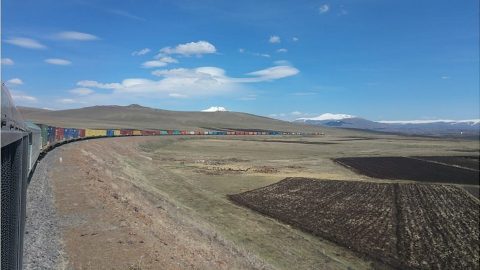Rail freight key to keep Australia’s grain market financially competitive

Bulk transport by rail is among a crop of measures from the Australian GrainGrowers, a national association reprinting the arable farming industry and its supply chain at large. Soaring costs, particularly in transportation, threaten to make home-grown grain financially unsustainable. That is a situation that GrainGrowers recognises as untenable. They seek to address it with the publication of their own policy document, designed to meet those challenges.
Australian farmers need an integrated approach to transportation costs. That’s the conclusion of the National Grain Freight Strategy, published by GrainGrowers. The document seeks to streamline the integration of road, rail, port, and shipping to make Australian grain financially competitive in the domestic and export markets. Rail freight has been identified as the single most valuable asset in delivering bulk loads to consumers.
Opportunities for standardisation and expansion
In the vast Outback of Australia, growers want to increase grain transport by rail. They say rail freight is a viable way to efficiently transport grain long distances from growing regions to ports. Even in the sparsely populated interior of the continent, the environmental benefits are well recognised, so says the Australian industry association GrainGrowers.

“Unfortunately, a localised rail network undermines the interoperability of the network, reducing overall freight efficiency and increasing costs,” says the GrainGrowers report. “Urgent work required includes targeted funding to upgrade critical rail freight corridors; the harmonisation of rolling stock access agreements across Rail Infrastructure Managers; an audit of infrastructure standards to identify opportunities for standardisation and expansion; and co-funding for industry to upgrade rail sidings and loading capacity.”
A record winter crop
Members of GrainGrowers recognise that moving their harvest to markets is a multimodal job. In that mix, rail freight plays a crucial role. Their new National Grain Freight Strategy urges the Australian federal government to help drive the sector’s global competitiveness. Launching the strategy, GrainGrowers Chair Rhys Turton said a unified and considered approach was vital to address a complex and multi-faceted issue.

Mr Turton explained that the grain freight supply chain was characterised by diverse, complex, and multidirectional freight journeys across multiple modes of transport. “In 2022-23, a record winter crop production of 65.7 million tonnes was moved from paddocks across regional Australia, by either road or rail to port for export or to domestic markets,” he said.
The single largest cost is transport
The expense of moving grain is the single largest cost of production. CSIRO, the Commonwealth Scientific and Industrial Research Organisation – an Australian Government agency, has examined the issue. Their modelling reflects transport costs of AUD$2.1 billion per annum. Australia also has an issue with its fragmented railway network. Different gauges and isolated sections make transcontinental operations by rail difficult (and costly).

“Increasingly, our ability to compete on the global stage is not just determined by what we grow, but also how efficiently and effectively we can get our grain to market,” said Rhys Turton. “For context, prior to the conflict between Russia and Ukraine, both countries’ production costs were AUD$70-$120 [per tonne] less than Australia’s [€40-70].”
Move millions of tonnes with billions of dollars
Grain production is a significant contributor to the Australian economy. According to recent figures from the Australian Bureau of Agricultural and Resource Economics and Sciences (ABARES), the gross value of grain for the 2022-2023 season was around AUD$20bn (€12.4bn). Crops are mainly wheat, barley, and canola.
It is the vast coal trains that make the headlines from Australia. However, grain is also a significant bulk cargo. Australian farmers harvest over 45 million tonnes annually. About sixty per cent of production goes to export. The major export markets include countries in Asia, the Middle East, and the Pacific. Even by Australian standards, that’s a lot of freight trains.




